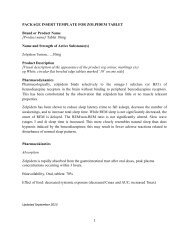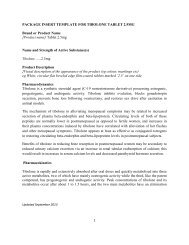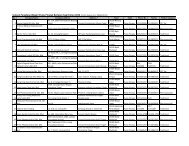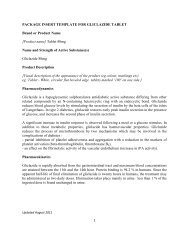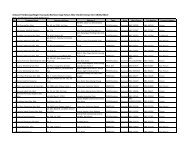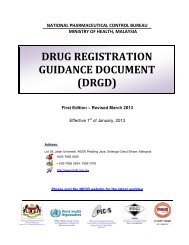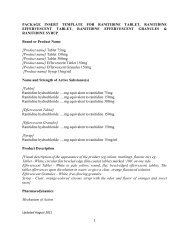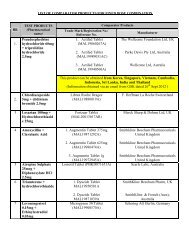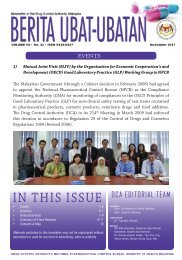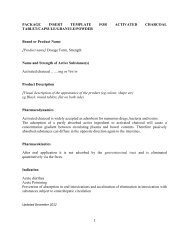Orodispersible/Orally Disintegrating Tablet - BPFK
Orodispersible/Orally Disintegrating Tablet - BPFK
Orodispersible/Orally Disintegrating Tablet - BPFK
- No tags were found...
Create successful ePaper yourself
Turn your PDF publications into a flip-book with our unique Google optimized e-Paper software.
PACKAGE INSERT TEMPLATE FOR LORATADINE ORODISPERSIBLE / ORALLYDISINTEGRATING TABLETBrand or Product Name[Product name] <strong>Orodispersible</strong>/<strong>Orally</strong> <strong>Disintegrating</strong> <strong>Tablet</strong> 10mgName and Strength of Active Substance(s)Loratadine 10mgProduct Description[Visual description of the appearance of the product (eg colour, markings etc)eg White, circular flat beveled edge tablets marked ‘100’ on one sidePharmacodynamicsLoratadine is a cyproheptadine, structurally related to azatadine. It exhibits potent, long-actingH 1 -antihistamine activity with no central sedative or anticholinergic effects. In man, nasal andother signs and symptoms of allergic rhinitis are relieved rapidly after oral administration.Loratadine is a tricyclic antihistamine with selective peripheral H 1 -receptor antagonistic activity.During studies of its effects on the CNS, loratadine has exhibited no depressant activity and noacute anticholinergic activity.Loratadine has exhibited a very low affinity for membrane receptors from the cerebral cortex anddoes not readily penetrate into the CNS. Whole body autoradiographic studies in rats andmonkeys, radiolabeled tissue distribution studies in mice and rats, and in vivo radioligand studiesin mice have shown that neither loratadine nor its metabolites readily cross the blood-brainbarrier. Radioligand binding studies with guinea pig pulmonary and brain H 1 -receptors indicatethat there was preferential binding to peripheral versus central nervous system H 1 -receptors.The sedation profile of loratadine, 10 mg once daily, is comparable to that of placebo and, duringlong term treatment, there were no clinically significant changes in vital signs, laboratory testvalues, physical examinations or electrocardiograms. Loratadine has no significant H 2 -receptoractivity, does not inhibit norepinephrine uptake and has practically no influence oncardiovascular function or on intrinsic cardiac pacemaker activity.Updated August 20111
PharmacokineticsAfter oral administration of loratadine in the conventional tablet formulation, the drug is rapidlyand well absorbed and undergoes an extensive first pass metabolism. In normal subjects, plasmadistribution half-lives of loratadine and its active metabolite are approximately 1 and 2 hours,respectively. Initial data in normal subjects demonstrated a mean elimination half-life of 12.4hours for loratadine and 19.6 hours for the active metabolite. Subsequent data in normal adultsubjects demonstrated mean elimination half-lives of 8.4 hours (range=3 to 20 hours) forloratadine and 28 hours (range=8.8 to 92 hours) for the major active metabolite. In nearly allpatients, exposure (AUC) to the metabolite was greater than exposure to the parent compound.Loratadine is highly bound (97% to 99%) and its active metabolite moderately bound (73% to76%) to plasma proteins. The bioavailability parameters of loratadine and of the activemetabolite are dose proportional. Approximately 40% of the loratadine dose is excreted in theurine and 42% in the feces over a 10-day period and that, mainly in the form of conjugatedmetabolites. Approximately 27% of the loratadine dose is eliminated in the urine during the first24 hours. Traces of unchanged loratadine and of its active metabolite were found in the urine.The pharmacokinetic profile of loratadine and its metabolites is comparable in healthy adultvolunteers and in healthy geriatric volunteers. In patients with chronic renal impairment, both theAUCs and peak plasma levels (C max ) increased for loratadine and its metabolite as compared tothe AUCs and peak plasma levels (C max ) of patients with normal renal function. The meanelimination half-lives of loratadine and its metabolite were not significantly different from thatobserved in normal subjects. Hemodialysis does not have an effect on the pharmacokinetics ofloratadine or its active metabolite in subjects with chronic renal impairment.In patients with chronic alcoholic liver disease, the AUC and peak plasma levels (C max ) ofloratadine were double while the pharmacokinetic profile of the active metabolite was notsignificantly changed from that in patients with normal liver function. The elimination half-livesof loratadine and its metabolite were 24 hours and 37 hours, respectively, and increased withincreasing severity of liver disease.Loratadine and its active metabolite are excreted in the breast milk of lactating women. Fortyeighthours after dosing, only 0.029% of the loratadine dose is detected in the milk as unchangedloratadine and its active metabolite.Pharmacokinetic studies showed that loratadine orodispersible tablet provides plasmaconcentrations of loratadine and its metabolite, descarboethoxyloratadine, that are similar tothose achieved with loratadine in conventional formulations.Updated August 20112
The effect of food on the pharmacokinetic profile of loratadine and its metabolite is not regardedas clinically significant. Consumption of food with loratadine orodispersible tablet may delaythe time and increase the extent of absorption without influencing clinical effects.The bioavailability of loratadine or its active metabolite was not compromised when a 10 mgloratadine orodispersible tablet tablet was placed on the tongue and swallowed without water.Loratadine orodispersible tablet may be taken with or without water.IndicationLoratadine orodispersible tablet is indicated for the relief of symptoms associated with allergicrhinitis, such as sneezing, nasal discharge (rhinorrhea) and itching, as well as ocular itching andburning. Nasal and ocular signs and symptoms are relieved rapidly after oral administration.Loratadine orodispersible tablet is also indicated for relief of symptoms and signs of chronicurticaria and other allergic dermatologic disorders.Recommended DosageAdults and Children 12 years of age and overOne loratadine orodispersible tablet (10 mg) placed in the mouth once daily. Allow the tablet todisperse in the mouth and swallow. Water or other liquid is not needed.Before administration, carefully peel off the foil and without crushing the tablet, remove it fromthe blister pack.Mode of AdministrationOralContraindicationsLoratadine orodispersible tablet is contraindicated in patients who have shown hypersensitivityor idiosyncrasy to their components.Warnings and PrecautionsPatients with severe liver impairment should be administered a lower initial dose because theymay have reduced clearance of loratadine; an initial dose of 10 mg (one tablet) every other day isrecommended.Updated August 20113
[Specific package insert requirement for loratadine]Warning :Drugs known to inhibit hepatic metabolism should be coadministered with caution untildefinitive interaction studies can be completed. The number of subjects who concomitantlyreceived macrolide antibiotics, ketoconazole, cimetidine, ranitidine, or theophylline along withloratadine in controlled clinical trials is too small to rule out possible drug interactions.Interactions with Other MedicamentsWhen administered concomitantly with alcohol, loratadine has no potentiating effects asmeasured by psychomotor performance studies.Loratadine is metabolised by hepatic cytochromes P450 3A4 and 2D6. Increase in plasmaconcentrations of loratadine has been reported after concomitant use with ketoconazole,erythromycin or cimetidine in controlled clinical trials, but without clinically significant changes(including electrocardiographic). Other drugs known to inhibit hepatic metabolism should becoadministered with caution until definitive interaction studies can be completed. Other drugsknown to inhibit either P450 3A4 or P450 2D6 are quinidine, fluconazole or fluoxetine.Loratadine orodispersible tablet may be administered without regard to meals.Drug/Laboratory Test InteractionsLoratadine orodispersible tablet should be discontinued 48 hours prior to skin testing proceduressince antihistamines may prevent or diminish otherwise positive reactions to dermal reactivityindicators.Statement on Usage During Pregnancy and LactationSafe use of loratadine orodispersible tablet during pregnancy has not been established; therefore,use only if potential benefit justifies potential risk to fetus.Updated August 20114
Since loratadine is excreted in breast milk and because of the increased risk of antihistamines forinfants, particularly newborns and premature infants, a decision should be made whether todiscontinue nursing or discontinue the drug.Adverse Effects / Undesirable EffectsLoratadine orodispersible tablet were well tolerated and did not cause local irritation or tasteabnormalities. Overall, the incidence of adverse reactions was comparable to that of placebo.The most frequently reported adverse effect was headache. Rarely reported undesirable effectsincluded somnolence, fatigue, dry mouth, dyspepsia, epistaxis and pharyngitis.During the marketing of loratadine in conventional formulations, alopecia, anaphylaxis, andabnormal hepatic function have been reported rarely.Overdose and TreatmentSomnolence, tachycardia and headache have been reported with overdoses of the conventionalloratadine formulation. A single dose of 160 mg caused no significant side effects.If necessary, the treatment of overdosage is symptomatic. Adsorption of any drugs remaining inthe stomach may be attempted by the administration of activated charcoal as a slurry with water,gastric lavage should be considered. Physiologic saline solution is the lavage solution of choice,particularly in children. In adults, tap water can be used; however, as much as possible of theamount administered should be removed before the next instillation. Saline cathartics draw waterinto the bowel by osmosis and, therefore, may be valuable for their action in rapid dilution ofbowel content. Loratadine is not cleared by hemodialysis to any appreciable extent. Afteremergency treatment, the patient should continue to be medically monitored.Storage ConditionsStore below ….CDosage Forms and Packaging Available[ Packaging type & pack size eg Alu-alu blister of 10s X 10/box, HDPE bottle of 30s/box etc ]Name and Address of Manufacturer[ Name & full address of manufacturer ]Name and Address of Marketing Authorization Holder[ Name & full address of marketing authorization holder ]Date of Revision of Package InsertUpdated August 20115
[ day/month/year ]Updated August 20116



